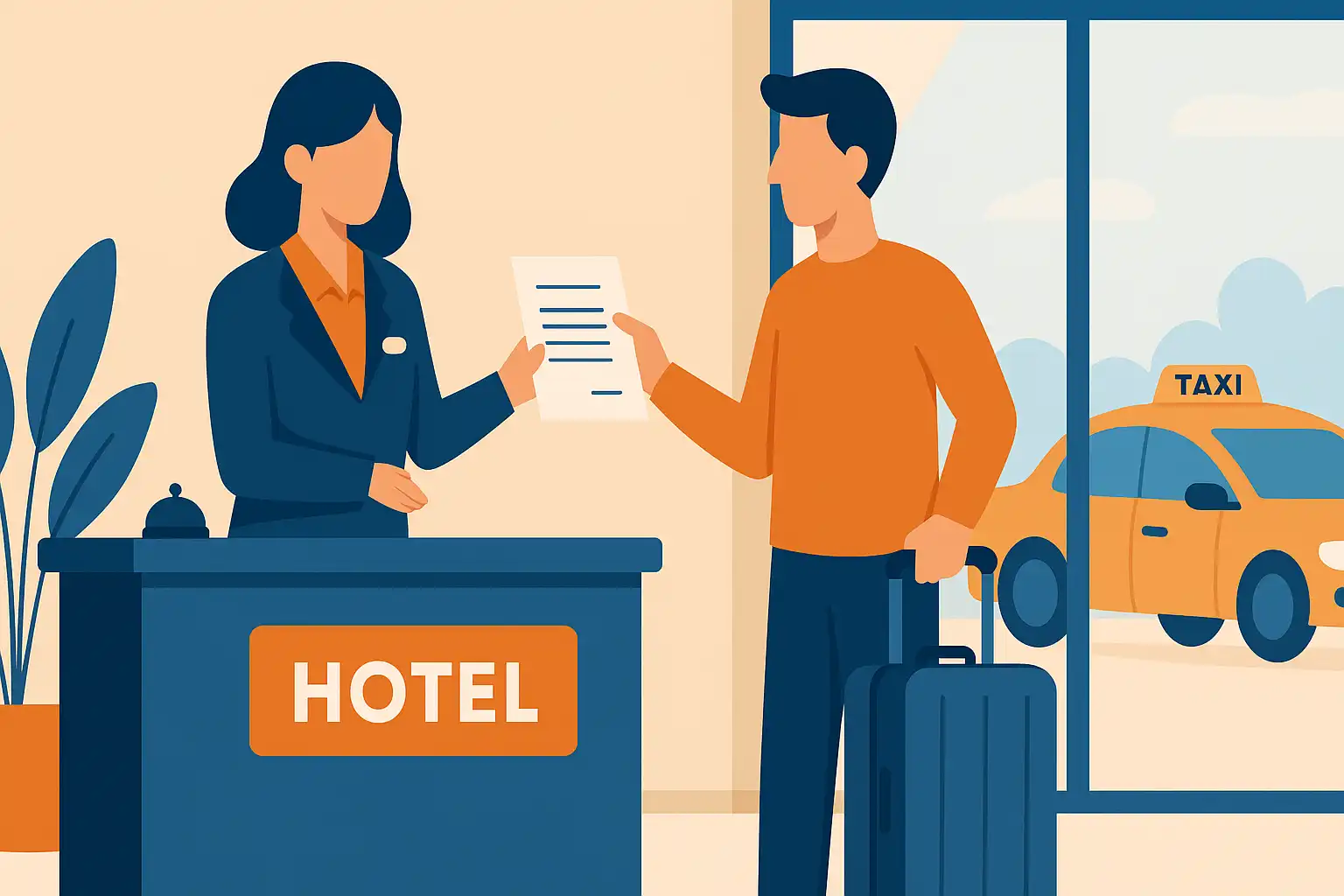15 Differences Between Hotels and Motels: A Complete Guide for Travelers
Jul 25, 2025
 Mika Takahashi
Mika TakahashiPopular Categories
Hotel Technology & InnovationHotel Operations OptimizationDigital MarketingIndustry TrendsRevenue ManagementHospitality Industry
Popular Categories
Trending Post

Hotel Walk Letter Template: Professional Guest Communication

Online Travel Agents: What They Are and How They Work

Hotel Security Systems: Modern Protection Solutions

Hotel Advertising: Complete Guide to Boost Bookings and Revenue

25 Hotel Marketing Strategy Ideas for 2025: Complete Guide

AI Reservation Agent: Revolutionizing Hotel Booking and Guest Experience

PMS Communication: Streamlining Property Management Through Effective Guest Messaging
Table of contents
Your upcoming travel plans will require you to decide between staying at hotels or motels as your accommodation choice. The distinction between hotel and motel accommodations affects your travel experience together with your budget and overall satisfaction. Travelers commonly confuse these terms because they provide different services to meet various requirements.
The selection between these accommodation types determines both your nightly expenses and the amenities you will have access to during your stay. Your travel experience will improve when you understand when to select hotels for business needs or motels for budget-friendly convenience.
This guide provides complete information about hotel and motel differences to help you select the best accommodation based on your travel preferences and budget requirements.
Key Differences Between Hotels and Motels
The difference between a hotel and a motel goes far beyond simple naming. These accommodation types represent different approaches in the hospitality industry, each designed for specific traveler needs and circumstances.
| Feature | Hotels | Motels |
|---|---|---|
| Location | City centers, urban areas, tourist destinations, airports | Major highways, rural areas, roadside locations |
| Structure | Multi story buildings with interior hallways | 1-2 story buildings with exterior room entrances |
| Amenities | Comprehensive: room service, fitness centers, swimming pools, concierge services | Basic amenities: parking, essential room features |
| Target Audience | Business travelers, families, tourists, luxury seekers | Road trippers, budget conscious travelers, short stays |
| Pricing | $150-$400+ per night (varies by location/category) | $50-$100 per night typically |
| Parking | Structured parking, valet services, parking lot | Direct parking spaces adjacent to rooms |
When to choose hotels: Select hotels for business trips requiring meeting rooms and professional services, family vacations needing diverse amenities, longer stays exceeding several nights, or when you prioritize comprehensive on site amenities and services.
When to choose motels: Opt for motels during road trips requiring quick overnight stops, when operating on a tight budget, for short-term stays (1-2 nights), or when you need easy access to your vehicle and prefer straightforward, no-frills accommodations.
The price range differences reflect each accommodation type’s business model. Hotels invest heavily in diverse range of amenities and services, justifying higher rates through value-added experiences. Motels focus on essential amenities and operational efficiency, allowing them to maintain lower costs while serving budget conscious travelers and road travelers effectively.
What is a Hotel?
A hotel serves as a complete hospitality facility which delivers accommodation along with culinary options and guest amenities for monetary compensation. Hotels stand apart from motels since they operate in multi-story buildings with interior hallways and centralized reception areas together with extensive common spaces which provide an immersive guest experience.
Hotels consist of two main characteristics which stem from their architectural style and their operational principles. The permanent lobby staff provides 24/7 security to guests who must access their rooms by using interior hallways rather than direct outside access. The building design emphasizes security measures along with climate management and controlled environment features that appeal to most tourists.
Hotels provide numerous amenities that set them apart from basic lodging facilities. Standard hotel amenities typically include:
- Room service for in-room dining convenience
- On site restaurant and bar facilities
- Concierge services for travel planning and reservations
- Fitness centers and swimming pool facilities
- Business centers with meeting rooms and conference facilities
- Laundry services and housekeeping
- Valet parking and bellhop services
The hotel industry employs a star rating scale from 1 to 5 stars to help guests evaluate the quality of service and available amenities. Five-star properties develop into luxurious resorts with spa services and multiple dining venues and premium in-room amenities while budget hotels concentrate on basic comforts with limited additional services.
Hotels place their establishments in strategic urban zones and city centers and near airports as well as in areas popular with tourists. The strategic location supports both corporate guests who want to be near business zones and conference areas and vacationers who need easy access to tourist attractions and shopping and entertainment facilities.
Hotels serve business travelers who want professional amenities and families who need diverse entertainment and tourists who require comprehensive services and individuals who value comfort and security when staying longer. Hotels meet various customer requirements through their accommodation selection that includes standard rooms and executive suites which provide advanced business amenities.
What is a Motel?
A motel received its name from "motor hotel" during the 1920s when automobiles started to popularize across America. The Motel Inn of San Luis Obispo California launched the first "motel" designation when it opened its doors in 1925 to become the model for this American lodging concept.
The basic motel architecture demonstrates its primary function which was to serve budget-friendly accommodation to travelers using cars. The architecture of motels consists of one or two-story buildings which normally adopt linear or U-shaped patterns. The rooms at these facilities have direct outdoor access which enables guests to park their vehicles next to their guestrooms in a central parking area.
The exterior-entrance design method gives priority to simple accessibility and quick movement for guests who need fast vehicle loading and unloading capabilities. The motor hotel concept caters to travelers who require easy vehicle access and clear visibility of their vehicles because this matters most to people who trip by car and those who need to quickly depart.
Motels purposefully restrict their amenities because they want to operate efficiently while keeping their prices affordable. Basic amenities typically include:
- Essential room furnishings (bed, television, basic bathroom facilities)
- Direct parking access for each room
- Sometimes a swimming pool or wi fi access
- Occasionally complimentary breakfasts or coffee service
- Basic housekeeping services
Motels operate under a business model which delivers clean accommodations while avoiding the expenses of extensive staffing and elaborate facilities. The business model of motels operates with minimal staff members including a front desk clerk and housekeeping staff which enables them to offer competitive rates to their targeted customer base.
Motels exist primarily in locations that include major highways and interstate interchanges and rural areas because they provide services to travelers passing through rather than tourists visiting specific locations. The strategic placement of motels along transportation routes allows drivers to notice them easily while providing fast access to guests who value efficient travel over luxurious features.
Motels welcome road trippers who want budget-friendly overnight stays as well as budget-conscious travelers and commercial drivers and traveling workers who require short-term functional lodging without additional services. Guests who use motels consider their accommodations mainly for rest and rejuvenation instead of seeking an experience-based vacation.
Location and Accessibility Differences
Hotels and motels maintain different geographic positions because their fundamental hospitality functions operate in distinct ways. Hotels choose to establish their operations in urban areas and city centers along with well-known tourist destinations because these locations offer valuable high land values and sufficient guest demand to justify vertical development and complete facilities.
Hotels find their optimal positions near airport terminals as well as downtown business districts and convention centers and key tourist attractions. Hotels position themselves close to corporate headquarters because they want to serve business travelers who require access to meeting spaces and professional services. Hotel locations in urban areas allow guests to use public transportation which helps them reduce their need for personal vehicles while allowing longer stays to explore the surrounding area.
Hotels in city center locations create value because they offer guests easy access to dining options and entertainment facilities as well as shopping and cultural attractions. Hotels serve travelers who want to discover their destination since guests can easily reach several locations by walking or using public transportation.
Motels establish their locations along major highways and interstate systems as well as rural areas to serve travelers who are in transit. Motorists driving along highways will easily spot these locations because they offer effortless entry and exit points that accommodate both large trucks and RVs which face challenges when parking in urban hotel spaces.
The choice of motel location emphasizes easy access above all else while sacrificing the availability of destination-based amenities. The combination of rural locations and highway positioning enables motels to keep their costs competitive while delivering necessary parking areas and suitable room layouts for travelers who move by road.
The parking arrangements of these establishments represent a major accessibility distinction between them. Hotels use three parking methods: structured garages with valet services and designated lots that force guests to walk between the parking area and their hotel room entrance. Additional parking fees exist in urban hotels because the limited space availability and expensive real estate costs require it.
Each motel offers immediate parking spaces that lead directly to room entrances which eliminates both the hassle of transporting luggage through extensive areas and the complexity of multiple parking facilities. Motel parking suits families with children and individuals with mobility issues as well as people who need to transport extensive equipment or merchandise.
The accessibility options between hotels and motels vary based on the space they offer for vehicles. Most motels offer better parking accommodations for RVs and commercial trucks than urban hotels since their parking spaces have larger dimensions and higher clearance.
Amenities and Services Comparison
Hotels vs motels differ primarily through their comprehensive amenities which reflect their business models and their targeted market expectations.
Hotels deliver complete guest amenities as part of their commitment to create full guest experiences. The on-site dining options at hotels include breakfast and lunch and dinner restaurants with room service availability as well as bars and lounges that serve both food and provide entertainment. Hotels maintain fitness centers which progress from basic rooms with exercise equipment to extensive facilities including personal trainers alongside group exercise programs and spa facilities.
Hotels standardize their fitness centers which evolve from simple equipment rooms to sophisticated facilities that offer personal trainers along with group classes and spa treatments. Hotel swimming facilities commonly include hot tubs as well as poolside service together with elaborate water features and several pool areas.
Hotels targeting business travelers feature amenities designed for professional guests. Hotels provide professional facilities to corporate guests by offering conference rooms, meeting spaces, business centers with printing services and executive lounges. Hotels that serve larger guest populations offer specialized event planning services along with facilities to host small business gatherings and big conventions.
Hotels that offer concierge services deliver personalized recommendations and local expertise and tour bookings and reservation assistance to their guests as part of their premium amenities. The level of service adds value to visitors who are new to their travel location or want extra benefits from their accommodation experience.
Hotels operate with increased personnel to maintain their various amenities. The combination of staff including front desk workers housekeepers restaurant staff maintenance team members and specialized service personnel forms a complete service environment which justifies higher pricing.
Motels concentrate on basic amenities which fulfill fundamental lodging requirements yet avoid complex or expensive elements. Standard motel accommodations consist of clean rooms with typical furniture which includes beds, televisions and basic bathroom facilities and sometimes small refrigerators and microwaves.
Some motels in warmer areas or along vacation routes provide swimming pools but these facilities lack additional amenities and service personnel. Wi fi access has become increasingly standard as traveler expectations for connectivity have evolved.
Motels maintain their operational philosophy through minimal amenities since they want to keep operational costs low while delivering practical accommodations. Motels function efficiently with their reduced staff through front desk operations during peak times and housekeeping duties that enable them to maintain affordable prices.
Most motels provide complimentary breakfast consisting of continental items including coffee, pastries and basic prepared foods. The services deliver worth to budget-conscious guests through straightforward operational needs that require minimum staff and preparation.
Hotels and motels differ in their service quality through consistent service delivery and availability of staff members. Hotels ensure continuous front desk availability 24/7 while they immediately respond to guest needs through staff training and supervision to achieve professional service standards.
The operational model of motels shows reduced staffing hours because they cater to basic accommodation needs without providing extensive support services.
Cost and Pricing Differences
Hotel pricing methods and motel pricing methods have distinct structures because hotels offer different value features together with operational expenses and market customer expectations. The knowledge of these price variations enables travelers to select accommodations that match their budget and their specific requirements.
Hotels require higher nightly rates because they provide complete amenities and operate in premium locations while bearing increased operational expenses. Hotels establish their average nightly prices according to their strategic position and seasonal requirements as well as their market segment position. Mid-tier hotels located in major cities tend to cost between $150 to $250 per night but luxury properties can reach prices above $400 for their standard rooms.
The pricing for budget hotels which share characteristics with upscale motels starts at $100 per night but they provide additional amenities compared to standard motels. Standard rooms in premium hotels located in preferred areas or during peak seasons will cost $500 or more especially in locations that attract tourists and business travelers.
Hotel pricing factors consist of desirable location value, full on-site amenities selection, service excellence levels, recognized brand value and seasonal market demand patterns. The convenience factor in locations close to airports and convention centers and major tourist sites leads hotels to increase their nightly rates.
The nightly prices at motels range from $50 to $100 for basic accommodations. Hotel costs remain affordable because they operate with minimal features and simple operations along with cost-effective systems that eliminate high-end hotel services such as room service and fitness centers and large staff.
The motel business model focuses on achieving maximum guest numbers through affordable rates instead of charging extra for additional amenities. The cost-effective approach of this pricing model benefits both budget-conscious travelers and commercial drivers and other price-sensitive guests who do not need luxurious features.
The prices of motels depend on several elements which include their position near highways as well as market competition and seasonal visitor flows and standard facilities. The nightly rates of motels near interstate roads or in markets with limited competition may be slightly elevated yet motels in competitive areas keep their prices at $60 or less.
Hotels implement dynamic pricing methods through which they change their room rates according to market conditions and regional events and reservation times. Business hotels adjust their weekend prices when corporate clients become less frequent while resort hotels increase their prices during vacation periods.
Additional fees represent another cost consideration. Hotel guests must pay various fees for amenities such as resort services and parking and Wi-Fi access which drive up the total bill for their stay. The hotel utilizes collected fees to support fitness centers and pools and business centers which form the basis of its extensive service framework.
Motels do not charge additional fees because they maintain open pricing that reflects their basic service model. Hotel guests can easily estimate their accommodation expenses since motels provide free parking along with basic facilities through their rate quotations.
The value proposition differs significantly between accommodation types. The complete set of services together with convenient locations and elevated comfort levels at hotels create value for guests who want to use these features despite their higher prices. Business professionals find that hotel conference spaces along with business facilities provide enough value to make up for the higher nightly costs.
The value of motel stays emerges from their efficient pricing system which delivers clean comfortable rooms to travelers without demanding extra service expenses. Multiple stop road trippers choose motels because their pricing enables them to spend more on activities and fuel and other travel expenses.
When to Choose a Hotel vs Motel
Choosing between hotels and motels depends on many factors such as trip duration, purpose, budget and personal preferences. Knowing when each type of accommodation provides the best value helps you make decisions that will enhance your overall experience.
Choose hotels for business travel when you need professional amenities like conference rooms, business centers, reliable Wi-Fi and room service. Business travelers benefit from hotel concierge services for restaurant reservations, transportation arrangements and local business contacts. The professional environment and services justify the cost when employers cover expenses or when business success depends on reliable accommodation services.
Family vacations prefer hotels when traveling with kids who need entertainment options, swimming pools and on site dining flexibility. Hotels provide security through interior hallways and controlled access, important for families with young kids. The variety of amenities keeps families occupied during weather delays or when they need downtime between activities.
Extended stays benefit from hotel amenities when trips are more than a few nights. Longer stays justify the premium for features like fitness centers, laundry services and room service that enhance comfort during extended periods away from home. Many hotels offer extended stay rates or loyalty program benefits that reduce costs for longer visits.
Urban destinations require hotels due to their location near attractions, restaurants and transportation hubs. City travel often involves walking, public transit or taxi services where hotel proximity to destinations provides a lot of value.
Choose motels for road trips when you need an affordable overnight stop during long distance travel. The direct parking access allows easy vehicle loading and unloading, important for families with luggage, sports equipment or other road trip essentials. Motels along the interstate provide convenient access without navigating complex urban hotel locations.
Budget travel favors motels when accommodation is just one of many expenses. Road travelers often prefer to allocate budget towards activities, dining experiences or fuel rather than paying for hotel amenities they won’t use during short stops.
Short term stays benefit from motel efficiency when you need clean and comfortable accommodations for one or two nights. Business travelers making short sales calls or contractors working temporary assignments often prefer motel simplicity over hotel complexity.
Rural destinations may require motels due to limited hotel options in remote areas. Scenic or rural locations along touring routes often have motels as the only accommodation option, especially in areas where hotel development isn’t feasible.
Think about your travel style when making accommodation decisions. Travelers who see accommodation as just a place to sleep and refresh may prefer motel efficiency and cost savings. Those who see accommodation as part of the overall experience may find hotel amenities and services worth the extra cost.
Assess your needs for each trip rather than defaulting to one type of accommodation. A business traveler may choose motels for regular sales trips but hotels for important client meetings or conference attendance.
Historical Background and Evolution
The development of hotels and motels demonstrates broader societal transformations related to transportation and social practices and changing traveler needs throughout history. The development process of these accommodation types has resulted in their distinct uses in modern hospitality services.
Hotels started in historical times when travelers on trade routes needed places to stay through the establishment of inns and guesthouses. During the time of ancient Greece and Rome societies built lodging facilities which provided accommodation together with dining areas and entertainment spaces and social areas for guests. The first establishments created a basic service model that modern hotels use in their operations.
Wealthy travelers during the 18th and 19th centuries developed luxury hotels as their social standing required matching accommodations. The Ritz Paris and the Savoy London developed hotel standards which continue to guide luxury hotel design through their sophisticated architectural elements and elaborate service systems and luxurious amenities.
Hotels began expanding across the United States during the railroad period as luxurious establishments built near train stations throughout major urban areas. These hotels operated as dual-purpose facilities because they catered to both visiting guests and residents who used their ballrooms, restaurants and meeting areas for social events as well as basic lodging needs.
During the 1920s the motorist’s hotel concept appeared as American car ownership rates surged across the nation. Motor courts offered basic accommodations to families who drove across America because automobile travelers needed different services than train passengers who spent extended periods with minimal luggage.
The Motel Inn of San Luis Obispo opened as the initial motel in 1925 introducing the fundamental characteristics which define motels today including external room entrances and nearby parking and streamlined services designed for motorist comfort. The property proved that travelers who used cars needed rapid access and simple parking and budget-friendly prices above all else.
The post-World War II period combined with interstate highway construction led to an explosive expansion of motel development. The new highway system provided stable traffic flow which led to profitable roadside lodging while the rising middle class could fund family road trips that sustained motel bookings.
The establishment of Holiday Inn in 1952 and Motel 6 in 1962 created motel standards while building widespread brand recognition to challenge independent hotels. These chains maintained their basic motel concept of affordable convenient accommodations but added standardization and reliability to their operations.
Hotels continued to develop specialized services and luxury accommodations during this period. Business hotels developed near airports and commercial districts to serve expanding corporate travelers while resort hotels in vacation locations expanded their entertainment and dining facilities.
The hotel industry developed various specialized segments which include boutique hotels with distinctive designs and extended-stay hotels for long-term guests and lifestyle hotels that target specific market segments. Hotels now implement technological solutions including mobile check-in and smart rooms and contactless services to match current guest expectations.
The budget hotel industry now competes with motels through comparable pricing options while providing superior features. Historic motels transformed into boutique hotels which blend roadside charm with modern minimalism to attract guests looking for authentic American roadside experiences.
The hospitality industry transforms because short-term rentals as an alternative accommodation option shifts how travelers perceive their stays and changes how businesses compete. Hotels emphasize their complete service offerings and luxury amenities but motels focus on delivering efficient accommodations at budget-friendly prices.
The hotel industry shows signs of traditional category convergence because budget hotels adopt motel-style exterior access while motels improve their amenities to create hybrid properties which merge hotel and motel characteristics to meet new traveler needs.
Conclusion
Hotels differ from motels through multiple fundamental distinctions which include design elements and location choices and amenities and pricing structures and target market segments. Hotels deliver complete services with urban accessibility and superior comfort which justify their premium prices for business travelers and families and destination visitors. Motels offer budget-friendly convenience to road trippers and budget-conscious travelers who need basic accommodations without luxury features.
Your travel accommodation selection should depend on your individual requirements instead of following strict guidelines. Hotel investments serve business travelers who need meeting facilities and professional services yet motels provide the best value for road travelers who stop briefly.
Knowledge about these differences enables you to select accommodations that both optimize your travel experience and minimize expenses. The selection between hotel services and motel efficiency depends on your travel requirements because the correct accommodation type will support your travel goals instead of creating complications.
The decision process for accommodation requires evaluation of your trip length and destination characteristics together with your financial limits and preferred amenities. The hospitality industry depends on hotels and motels which provide essential services to travelers who should select the best option for their specific needs to achieve maximum satisfaction and budget efficiency.
